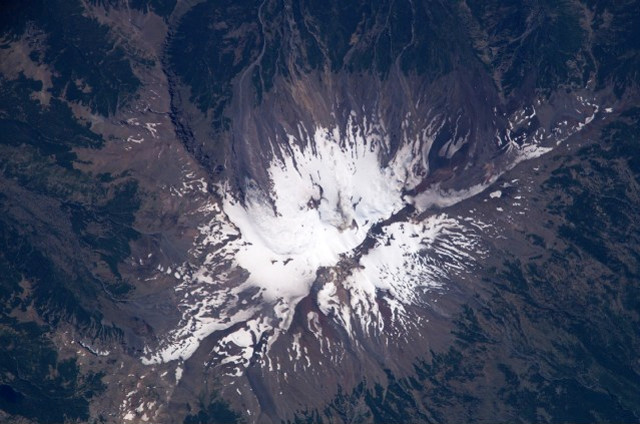
by John Copeland Thursday, June 22, 2017

A view from space of the Copahue volcano in Argentina. Credit: Public Domain.
Volcanoes never cease to fill me with awe. Volcanism has been a part of Earth’s history since the planet formed about 4.6 billion years ago, and volcanoes continue to punctuate the fiery, dramatic and ongoing creation story of our planet. I have been fortunate to visit several volcanoes around the world while filming science documentaries, and even descended into the vent of Copahue, an active volcano in the Neuquén province of Argentina.
One thing that fascinates me about volcanoes is their ability to impact life beyond their immediate surroundings. Eruptions can cause rapid and widespread devastation, but they also give rise to islands and create mineral-rich soils in which plants thrive. Earth scientists have singled out instances of volcanism that appear to have impacted the evolution of life. The Siberian Traps, for example, were a likely contributor to the end-Permian mass extinction roughly 252 million years ago, and the Deccan Traps in India may have had a hand in the extinction of the dinosaurs 66 million years ago. Most of us rarely, if ever, stop to think how natural disasters, like volcanic eruptions, might have impacted ancient life on Earth.
In 2000, as I was completing a special on dinosaurs for the Discovery Channel, I read about Eric Roberts and Marc Hendrix, then graduate students at the University of Montana, who reported a fascinating finding from the Elkhorn Mountain Volcanic province in northwestern Montana and southern Alberta, Canada. Some 74 million years ago, during the Cretaceous, this area was near the western edge of the Western Interior Seaway — a habitat for a diverse and abundant number of dinosaurs. Roberts and Hendrix found evidence that a forest had been toppled, charred and entombed in volcanic ash. This ash flow was gigantic, leaving deposits about 3 meters thick as far away as the Dakotas and Nebraska, nearly 1,450 kilometers from the source. Within the forest remains, they also discovered charred fragments of dinosaur bone from hadrosaurs and theropods.
Ancient human ancestors would have known volcanic landscapes well too. We know they used obsidian for making stone tools, and likely revered the fiery vents in the same way Hawaiian islanders have traditionally revered the goddess Pele. In Turkey, at the site of the Neolithic city of Çatalhöyük, a nearly 10,000-year-old mural depicts an explosive eruption of Hasan Dağı, a volcano about 130 kilometers northeast of Çatalhöyük. Although controversial, this is possibly the oldest recording of a volcanic eruption by humans.
A little closer to our own time was the eruption of Mount Tambora in Indonesia in 1815, often referred to as the most powerful eruption in recorded history. The eruption, which lasted for two weeks, was a hundred times larger than Mount St. Helens’ blast in 1980, throwing 50 cubic kilometers of gas, dust and rock into the atmosphere. An estimated 10,000 island inhabitants died instantly.
The Tambora eruption had far-flung consequences that scientists continue to study. Debris from the volcano shrouded and chilled parts of Earth for months, contributing to crop failures and famine in North America and epidemics in Europe. Climate experts believe that Tambora was partly responsible for the unseasonable chill that afflicted much of the Northern Hemisphere in 1816, known as the “year without a summer.” In June 1816, a blizzard pummeled upstate New York. That July and August, killer frosts in New England ravaged farms. Hailstones pounded London all summer.
Even though Mount Tambora erupted more than 200 years ago, we have powerful visual evidence of its impact on the planet. The paintings of English landscape artist J.W.M. Turner, like “Chichester Canal,” reveal skies ethereally colored by volcanic particulates blasted into the atmosphere.
A 2015 article in Nautilus Magazine by Gillen D’Arcy Wood featured this evocative summation of Tambora’s impact: “For three years following Tambora’s explosion, to be alive, almost anywhere in the world, meant to be hungry. Across the globe, harvests perished in frost and drought, or were washed away by flooding rains.”
Viewed from a distance, volcanoes and volcanic eruptions are a marvel of nature. But as with so many of Earth’s wonders, a beautiful visage can mask significant danger. Life, for as long as it has tenaciously existed, has been vulnerable to Earth’s calamitous events, just as it is today.
© 2008-2021. All rights reserved. Any copying, redistribution or retransmission of any of the contents of this service without the expressed written permission of the American Geosciences Institute is expressly prohibited. Click here for all copyright requests.